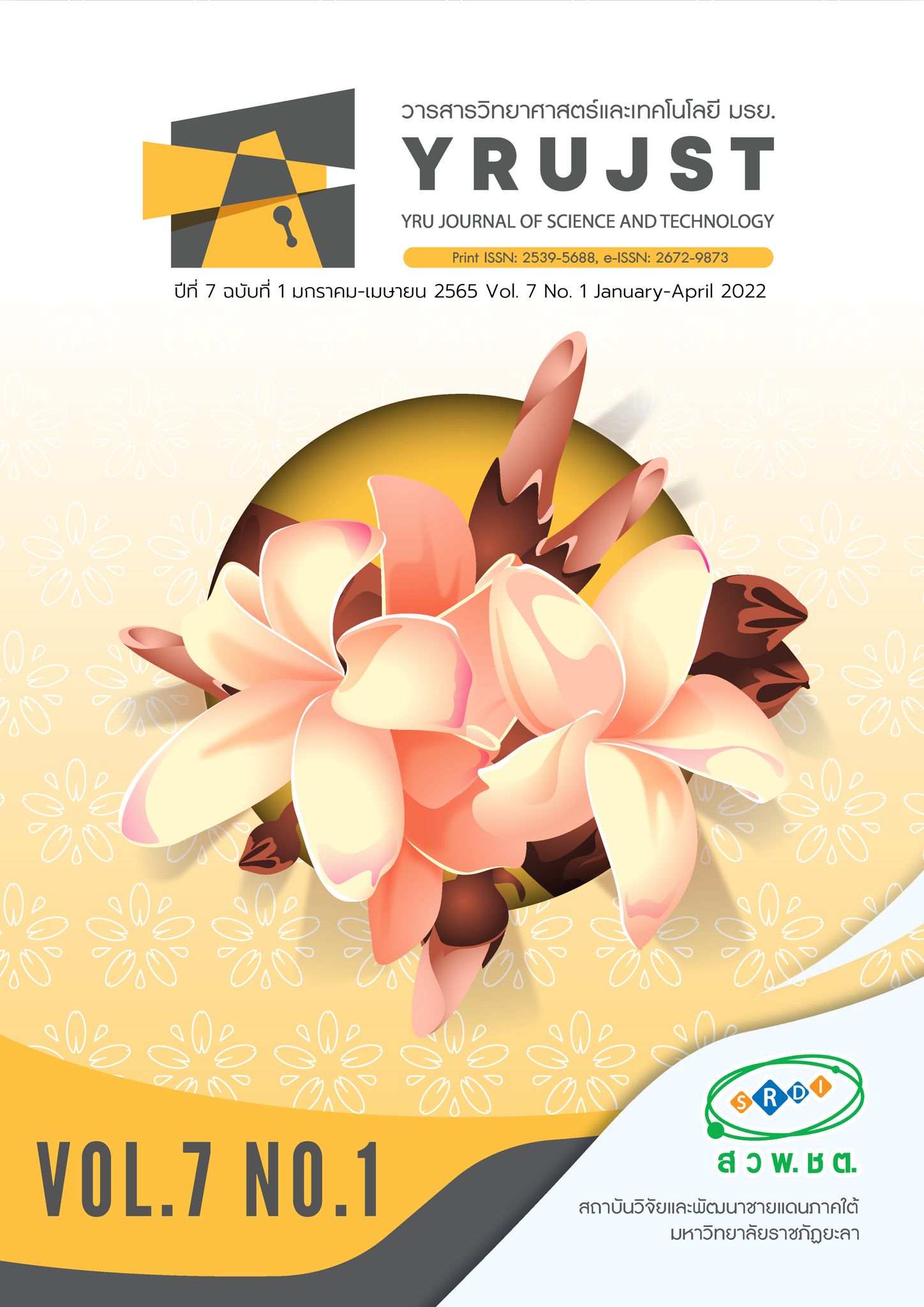ปริมาณสารประกอบฟีนอลิก ฟลาโวนอยด์ และฤทธิ์ต้านอนุมูลอิสระ ของดอกกล้วยไม้สกุลหวาย ในมหาวิทยาลัยแม่โจ้ จังหวัดเชียงใหม่
Main Article Content
บทคัดย่อ
ดอกกล้วยไม้สกุลหวาย (เอื้องผึ้ง เอื้องมะลิ และเอื้องสายไหม) จากมหาวิทยาลัยแม่โจ้ ได้นำมาตรวจวิเคราะห์ หาปริมาณสารประกอบฟีนอลิกรวม และปริมาณสารประกอบฟลาโวนอยด์รวม โดยใช้วิธี Folin-ciocalteu และปฏิกิริยาการเกิดสีด้วยอะลูมิเนียมคลอไรด์ สำหรับฤทธิ์ต้านอนุมูลอิสระวิเคราะห์ด้วยวิธีการยับยั้งด้วย 2, 2-Dyphenyl-1-picrylhydrazyl (ดีพีพีเอช) จากผลการทดลองพบว่าดอกกล้วยไม้เอื้องผึ้งพบสารประกอบฟีนอลิกรวม และสารประกอบฟลาโวนอยด์รวมสูงที่สุด (39.81 มิลลิกรัมสมมูลของกรดแกลลิก ต่อน้ำหนักกรัมสารสกัดหยาบ และ137.68 มิลลิกรัมสมมูลเคอร์ซิติน ต่อน้ำหนักกรัมสารสกัดหยาบ ตามลำดับ) และฤทธิ์ต้านอนุมูลอิสระ (IC50 เท่ากับ 0.21 มิลลิกรัมต่อสารละลายตัวอย่าง 1 มิลลิลิตร) ความสัมพันธ์ระหว่างปริมาณสารประกอบฟีนอลิกรวมกับฤทธิ์ต้านอนุมูลอิสระด้วยวิธีดีพีพีเอชมีความสัมพันธ์กันสูงมาก (ค่าสัมประสิทธิ์สหสัมพันธ์เท่ากับ -0.925) และมีความสัมพันธ์ปานกลางระหว่างปริมาณสารประกอบฟลาโวนอยด์กับฤทธิ์ ต้านอนุมูลอิสระด้วยวิธีดีพีพีเอช (ค่าสัมประสิทธิ์
สหสัมพันธ์เท่ากับ -0.693) การศึกษานี้แสดงให้เห็นว่ากล้วยไม้สกุลหวายเหล่านี้เป็นแหล่งของสารต้านอนุมูลอิสระตามธรรมชาติโดยเฉพาะอย่างยิ่งดอกกล้วยไม้เอื้องผึ้ง
Article Details
บทความ ข้อมูล เนื้อหา รูปภาพ ฯลฯ ที่ได้รับการเผยแพร่ในวารสารวิทยาศาสตร์และเทคโนโลยี มรย. นี้ ถือเป็นลิขสิทธิ์ของวารสารวิทยาศาสตร์และเทคโนโลยี มรย. หากบุคคลหรือหน่วยงานใดต้องการนำทั้งหมดหรือส่วนหนึ่งส่วนใดไปเผยแพร่ต่อหรือกระทำการใดๆ จะต้องได้รับอนุญาตเป็นลายลักษณ์อักษรจากวารสารวิทยาศาสตร์และเทคโนโลยี มรย. ก่อนเท่านั้น
เอกสารอ้างอิง
Cakova, V., Bonte, F. & Lobstein, A. (2017). Dendrobium: Sources of active ingredients to treat age related pathologies. Aging and Disease, 8(6), 827-849.
Das, S., Ray, A., Nasim, N., Nayak, S. & Mohanty, S. (2019). Effect of different extraction techniques on total phenolic and flavonoid contents, and antioxidant activity of betelvine and quantification of its phenolic constituents by validated HPTLC method. 3 Biotech, 9(37), 1-8.
Gupta. A. (2017). Antioxidants from medicinal plants and their relevance to human health. India: PP Savani University.
Halee, A. & Rattanapun, B. (2017). Study of antioxidant efficacies of 15 local herbsม KMUTT Research and Development Journal, 40(2), 283-293. (in Thai)
Jullapo, N. (2016). Phytochemical screening and biological activities of Dendrobium spp. Master’s Thesis. Burapha University. (in Thai)
Nachaikong, T., Wanyawa, A. Kaoian, K., Kongsooknirundorn, J., Supathirasakul, S., Wongnava, M. & Bumrungwong, N. (2014). Antioxidant and iron-chelating activity of some Thai medicinal plants, KKU Science Journal, 42(1),149-158.
Nguyen, H. A., Lin, K. H., Huang, M. Y., Yang, C. M., Shin, T. H., Hsiung, T. C., Lin, Y. C. & Tsao, F. C. (2018). Antioxidant activities of the methanol extracts of various parts of Phalaenopsis Orchids with white, yellow, and purple flowers, Notulae Botanicae Horti Agrobotanici Cluj-Napoca, 46(2),457-465.
Obsuwan. K., Jeong, B. R. & Maksup, S. (2019). Analysis of bioactive compounds, polysaccharides and antioxidant activity in different parts of Dendrobium Sonia Jo Daeng, Science, Engineering and Health Studies, 13(2), 73-82.
Phottraithip, A., Prapalert. W & Chotikadachanarong, K. (2019). Conservation and use of orchids in Ban Hua Thung Chiang Dao District Chiang Mai Province. Online. Retrieved November 27, 2020, from: http://www.cmruir.cmru.ac.th/bitstream/123456789/1929/5/Chapter2.pdf. (in Thai)
Phunsawan, B. (2013). Free radicals, Antioxidants and Antioxidant Activity Determination. Thai Journal of Science and Technology, 21(3), 275-286. (in Thai).
Prapalert. W, Phottraithip, W., & Chotikadachanarong, K. (2019). Study of the activity of phytochemicals in wild orchids. and propagation guidelines for communities. Online. Retrieved November 28, 2020, from: http://www.research.cmru.ac.th/research59/ris/view.php?no=904. (in Thai)
Prommajak, T., Surawang, S & Rattanapanone, N. (2014). Ultrasonic-assisted extraction of phenolic and antioxidative compounds from lizard tail (Houttuynia cordata Thunb ,Songklanakarin Journal of Science and Technology, 36(1), 65-72.
Rabeta, M. S. & Vithyia, M. (2013). Effect of different drying methods on the antioxidant properties of Vitex negundo Linn. Tea, International Food Research Journal, 20(6), 3171-3176.
Selamoglu, Z., Amin, K. & Ozgen, S. (2018). Plant secondary metabolites with antioxidant properties and human health. Turkey: Gece Publishing.
Shirazi, O. U., Khattak, M. M. A. K., Nor Shukri, A. M. & Nasyriq, M. N. A. (2014). Determination of total phenolic, flavonoid content and free radical scavenging activities of common herbs and spices, Journal of Pharmacognosy and Phytochemistry, 3 (3), 104-108.
Siriwattanamethanon, N. (2020). Multi-coloured food There are many benefits (Part 1): What are multicolored foods. Online Retrieved November 30, 2020, from:https://pharmacy.mahidol.ac.th/knowledge/files/0148.pdf. (in Thai)
Sridhar, K. & Charles, A. L. (2019). In vitro antioxidant activity of Kyoho grape extracts in DPPH and ABTS assays: Estimation methods for EC50 using advanced statistical programs, Food Chemistry,257,41-49.
Spiridon, I., Bodirlau, R. & Teaca, C. A. (2011). Total phenolic content and antioxidant activity of plants used in traditional Romanian herbal medicine, Central European Journal of Biology, 63(30), 388-396.
Tanagornmeatar, K., Sritularak, B. & Likhitwitayawuid. K. (2014). Chemical constituents of Dendrobium ellipsophyllum and their cytotoxic activity on KB cells. The 14th Graduate Researchconferences, February 22, 2014. Khon Koen: Khon Koen University. (in Thai)
Ueda, Y., Apiphuwasukcharoen, N., Tsutsumi, S., Matsuda, Y., Areekul, V. & Yasuda, S. 2019. Optimization of hot-water extraction of dried yacon herbal tea leaves: enhanced antioxidant activities and total phenolic content by response surface methodology, Food Science and Technology Research, 25(1), 131.139.


